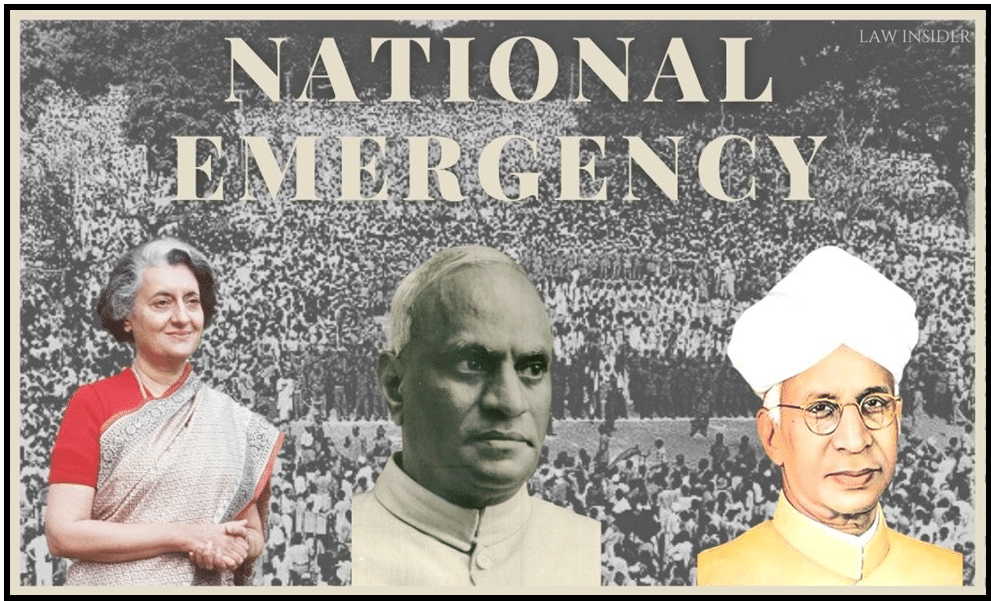ONLY BY ETERNAL VIGILANCE – EMERGENCY
SYLLABUS:
GS 2:
- Indian Constitution—historical underpinnings, evolution, features, amendments, significant provisions and basic structure.
Focus:
- Emergency is a reminder of the need to protect the rights and freedoms of individuals in society.
Source: LAW INSIDER
Definition and Authority
- Crisis Governance: A state of emergency in India refers to a period of governance proclaimed by the President of India during crisis situations.
- Presidential Powers: Under the advice of the cabinet of ministers, the President can override many constitutional provisions, including Fundamental Rights.
- Constitutional Basis: The emergency provisions are detailed in Part XVIII of the Constitution of India, from Articles 352 to 360.
- Purpose: These provisions enable the Central government to address abnormal situations effectively.
- Rationale: The aim is to safeguard the country’s sovereignty, unity, integrity, security, the democratic political system, and the Constitution.
Types of Emergencies
- National Emergency: Declared based on war, external aggression, or armed rebellion.
- Constitutional Emergency: Also known as President’s Rule, declared when a state government cannot function according to constitutional provisions.
- Financial Emergency: Declared when India’s financial stability or credit is threatened.
Emergency: A Reminder to Protect Rights and Freedoms
- Historical Context: The Emergency imposed in India on June 25, 1975, serves as a powerful reminder of the need to protect individual rights and freedoms. It was declared not because of a genuine threat but due to political insecurity.
- Article 352: This article in the Indian Constitution allows for the proclamation of a national emergency on grounds such as war, external aggression, or internal disturbances. The Emergency of 1975 was the third in India’s history but the most infamous.
- Widespread Resentment: The period leading up to the Emergency saw widespread resentment against the government, fueled by corruption, concentration of power, and undermining of democratic institutions.
- Impact on Democracy: The Emergency period was marked by the suspension of fundamental rights and the imposition of draconian measures, highlighting the fragility of democracy.
- Judiciary’s Role: Key judicial decisions during this period, such as those by the Allahabad High Court and the Supreme Court, played a crucial role in the unfolding of events, underlining the importance of an independent judiciary.
Accountability of Government Actions
- Political Consequences: The Emergency had severe political repercussions, including the nullification of the Prime Minister’s election by the Allahabad High Court and subsequent public outrage.
- Public Response: The general elections post-Emergency saw a significant shift as the electorate rejected the ruling party, illustrating that people will hold governments accountable for undermining constitutional values.
- Fundamental Rights: The Emergency underscored the importance of fundamental rights, with the public rejecting any infringement on their freedoms, even in times of crisis.
- Democratic Governance: The episode emphasized that democratic governance must be rooted in participation, consultation, and consensus, avoiding despotic tendencies.
- Legal Framework: It is crucial for governments to operate within the constitutional framework and uphold the rule of law, as deviations can lead to significant backlash and loss of public trust.
Lessons for the Future
- Value of Dignity: The Emergency taught that people value dignity and self-respect alongside material needs, and any threat to their fundamental rights will be met with resistance.
- Media’s Role: The media’s role during the Emergency, with notable exceptions, was criticized for failing to stand up to governmental overreach, highlighting the need for a free and courageous press.
- Youth Education: Educating the youth about the Emergency and its consequences is essential to prevent the repetition of such dark chapters in history.
- Preventive Measures: Learning from the excesses of the Emergency, it is vital to implement measures that safeguard democratic institutions and prevent the abuse of power.
- Civic Vigilance: The Emergency serves as a stark reminder that eternal vigilance by citizens is essential to maintain liberty and democracy.
Conclusion
The Emergency period in India serves as a powerful lesson on the importance of protecting individual rights and upholding democratic principles. The dark chapter underscores the need for constant vigilance, accountability, and adherence to constitutional values to ensure that such an episode is never repeated.
| National Emergency
Grounds for Declaration
Examples and Legal Precedents
Parliamentary Approval and Duration
Effects and Revocation
Constitutional Emergency (President’s Rule) Grounds and Procedures
Consequences
Judicial Review
Financial Emergency Grounds and Effects
Consequences
Criticisms and Safeguards
|
Source:Indian Express
Mains Practice Question:
Discuss the role of the judiciary during the Emergency period in India. How did judicial decisions influence the political scenario, and what lessons can be drawn for the independence of the judiciary today?
Associated Articles:




